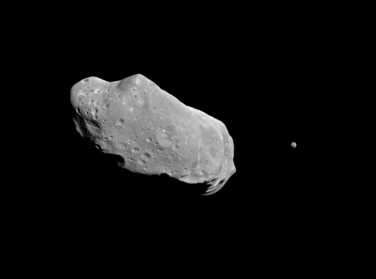On August 28, 1993, Galileo came within 2,400 km (1,500 miles) of the asteroid
Ida and made another remarkable discovery, Dactyl, the first
confirmed moon orbiting an asteroid.
 Ida and its moon Dactyl. Credit: NASA.
Ida and its moon Dactyl. Credit: NASA.
Ida is twice the size of Gaspra at 56 x 24 x 21 km (35 x 15 x 13 miles). Dactyl is tiny by comparison at about 1.2 x 1.4 x 1.6 km (0.75 x
0.87 x 1 mile) across. The name comes from the Dactyli, a group of mythological
beings who lived on Mount Ida. The Dactyli guarded the infant Zeus after the
nymph Ida secretly raised the god on the mountain.
 This montage of 14 images (the time order is right to left, bottom to top) shows Ida as it appeared in the field of view of Galileo's camera on August 28, 1993. Asteroid Ida rotates once every 4 hours, 39 minutes and clockwise when viewed from above the north pole; these images cover about one Ida 'day.' This sequence has been used to create a 3D model that shows Ida to be almost croissant-shaped. The earliest view (lower right) was taken from a range of 240,000 km (150,000 miles), 5.4 hours before closest approach. The asteroid Ida draws its name from mythology, in which the Greek god Zeus was raised by the nymph Ida. Credit: NASA.
This montage of 14 images (the time order is right to left, bottom to top) shows Ida as it appeared in the field of view of Galileo's camera on August 28, 1993. Asteroid Ida rotates once every 4 hours, 39 minutes and clockwise when viewed from above the north pole; these images cover about one Ida 'day.' This sequence has been used to create a 3D model that shows Ida to be almost croissant-shaped. The earliest view (lower right) was taken from a range of 240,000 km (150,000 miles), 5.4 hours before closest approach. The asteroid Ida draws its name from mythology, in which the Greek god Zeus was raised by the nymph Ida. Credit: NASA.

